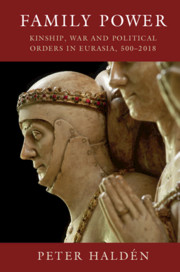Book contents
- Family Power
- Family Power
- Copyright page
- Contents
- Preface and Acknowledgements
- Chronology
- 1 Introduction
- 2 How Social Science Separated Families from Political Order
- 3 Formless Kinship in Formless Polities
- 4 Consolidating Dynasties and Realms
- 5 Strong Aristocracies in Strong States
- 6 The Revival and Sudden Death of Political Kinship
- 7 The Arab Empires c.632–c.900
- 8 Sacred Yet Supple
- 9 The Ubiquitous and Opaque Elites of the Ottoman Empire c.1300–c.1830
- 10 Clans and Dynasties in the Modern Middle East
- 11 Conclusions
- Bibliography
- Index
10 - Clans and Dynasties in the Modern Middle East
Somalia and Saudi Arabia
Published online by Cambridge University Press: 09 March 2020
- Family Power
- Family Power
- Copyright page
- Contents
- Preface and Acknowledgements
- Chronology
- 1 Introduction
- 2 How Social Science Separated Families from Political Order
- 3 Formless Kinship in Formless Polities
- 4 Consolidating Dynasties and Realms
- 5 Strong Aristocracies in Strong States
- 6 The Revival and Sudden Death of Political Kinship
- 7 The Arab Empires c.632–c.900
- 8 Sacred Yet Supple
- 9 The Ubiquitous and Opaque Elites of the Ottoman Empire c.1300–c.1830
- 10 Clans and Dynasties in the Modern Middle East
- 11 Conclusions
- Bibliography
- Index
Summary
The Ottoman Empire is the most long-lived Islamic polity in world history. It is of particular interest to understanding if kinship is incompatible with or in fact central to stable political order. A long tradition in Western political and social thought argues that the Ottoman Empire terminated hereditary elite groups and established an impersonal despotic state in which all subjects, from the most exulted vizir to the most humble Anatolian peasant, were slaves of the sultan. This is also the image given by Ottoman political theory. Since the Renaissance Western social and political thought has tended to cast the Ottoman Empire as the radical ‘other’ of European realms. The efficiency and seemingly absolute rule of the sultans were originally the envy of European observers. To them, the Ottoman Empire differed from Europe where hereditary lords were essential and without whose support kings were powerless (Machiavelli, 1993:30–1; Çirakman, 2002:62ff; Bisaha, 2004). Later, the image of the Ottomans shifted. In the nineteenth century the weakened Empire was often portrayed as the ‘sick man of Europe’.
Keywords
- Type
- Chapter
- Information
- Family PowerKinship, War and Political Orders in Eurasia, 500–2018, pp. 283 - 309Publisher: Cambridge University PressPrint publication year: 2020



